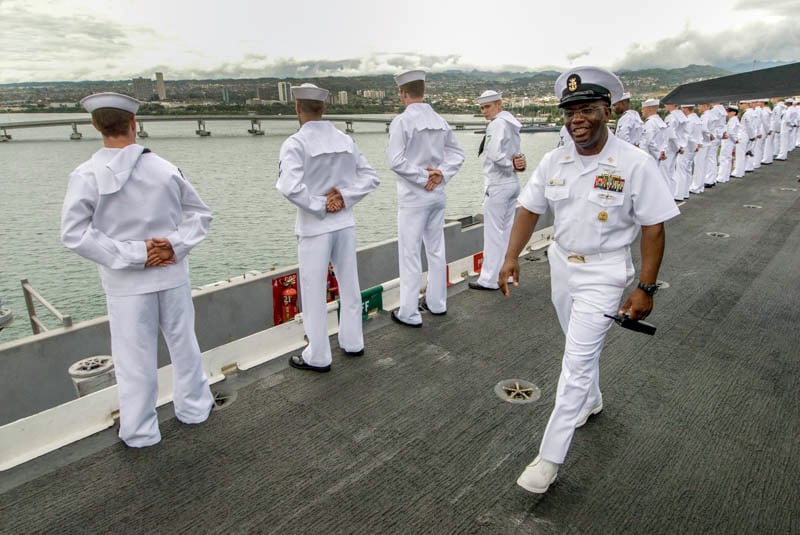Nearly 29 years ago, a A young immigrant boy named Charles Clarke, walked through the doors of the Military Entrance and Processing Station in New York City nearly 29 years ago and into the United States Navy.
On Friday, Dec. 18, Fleet Master Chief (SW/AW/IDW) "Chuck" Clarke walked out the of the Navy's door as one of the top five enlisted sailors in the service — one sought after for his advice and counsel by all ranks — those both below and above him.
"The true mark of a leader is someone who knows how to lead not only those under them, but those senior to them as well, " said Adm.iral Bill Gortney, currently the current head of U.S. Northern Command who hired Clarke in 2012 to be the Fleet Forces Command fleet master chief in 2012 when it was under Gortney's command.
"Chuck Clarke is that kind of leader."
Gortney returned to Norfolk to serve as Clarke's guest speaker at a retirement ceremony at the Joint Forces Staff College, just a stone's throw from the building they served together in overseeing the hundreds of ships and aircraft, as well as the tens of thousands of sailors who operate them.
In his lite light and lively tribute to Clarke, Gortney said Clarke stood out that when he was reviewing packages to hire a new top enlisted sailors for FFC. , Clarke Stood out.
"It was pretty obvious from the minute I reviewed his package who the selectee was going to be," Gortney said.
His subsequent interviews with Clarke and other candidates bore out that initial reaction, he said, stating that Clarke's leadership and knowledge of the Navy were critical to his own success as the fleet commander.
Among the challenges the two faced in the job was the discovery that the Navy Working Uniform Type I was not only non-fire retardant, it was found to be burn quickly and was a potential hazard to sailors since it quickly burned. Clarke was a key member of Gortney's team to quickly identify an interim, solution and fire retardant solution as well as the is part of the ongoing effort to find a permanent solution for a uniform that is flame resistant.
In addition, Clarke also helped the fleet adopt a non-punitive breathalyzer program to help educate sailors about alcohol use and abuse.

Command Master Chief (SW/AW) Chuck Clarke troops the line along the flight deck of the aircraft carrier Kitty Hawk on June 30, 2008, as the ship pulls into Pearl Harbor for a port visit and to participate in the Rim of the Pacific Exercise.
Photo Credit: Mark D. Faram/Staff
Lauding Clarke for having made nine deployments during his career, Gortney praised his work ethic and described him as the "epitome" of a decollate deckplate leader, one who was never disgruntled and who always "carried on with pride and determination," he said. "He is a fleet sailor taking care of fleet sailors."
And he did it all with a smile, Gortney, said, and with a talent to use little sayings that many now call "Fleetisms" to drive his points home with everyone — regardless of rank.
"I bring your attention to the back of your programs," Gortney said of a listing of Clark's well known sayings. "Especially the one that says, 'eEvery interaction with a sailor is a training opportunity.' wWhen I first heard that, I thought about how try true that really was — and then I realized that I was a sailor, too."
Born and raised in Guyana, a place Clarke describes as a "small country in South America," Clarke attended boot camp in San Diego in early 1987.
Rising through the ranks, first as a disbursing clerk and later as a nNavy counselor, and he was selected into the command master chief program, where his first tour as a senior enlisted leader was on the forward-deployed aircraft carrier Kitty Hawk.
Though While not unheard of, — though, even Gortney made a point to say that it's quite a rare accomplishment, — one with Clarke followed up his first tour on an aircraft carrier with his a second tour one, onboard the an aircraft carrier, this time on the Nimitz as well.
When he got the tap on the shoulder to be Gortney's "fleet," Clarke had spent 24 months in Bahrain as the tope enlisted sailor in 5th Fleet.
Though thought by many as a strong candidate to be the next master chief petty officer of the nNavy, Clarke said that a key part of being a leader is knowing when it's time to move on.
"I will always cherish the memories I've had as a member of the United States Navy," Clarke said. "Next to marrying my wife, joining the Navy it was the wisest decision I ever made."
Mark D. Faram is a former reporter for Navy Times. He was a senior writer covering personnel, cultural and historical issues. A nine-year active duty Navy veteran, Faram served from 1978 to 1987 as a Navy Diver and photographer.









